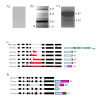Genome-wide analysis of alternative splicing in Chlamydomonas reinhardtii
- PMID: 20163725
- PMCID: PMC2830987
- DOI: 10.1186/1471-2164-11-114
Genome-wide analysis of alternative splicing in Chlamydomonas reinhardtii
Abstract
Background: Genome-wide computational analysis of alternative splicing (AS) in several flowering plants has revealed that pre-mRNAs from about 30% of genes undergo AS. Chlamydomonas, a simple unicellular green alga, is part of the lineage that includes land plants. However, it diverged from land plants about one billion years ago. Hence, it serves as a good model system to study alternative splicing in early photosynthetic eukaryotes, to obtain insights into the evolution of this process in plants, and to compare splicing in simple unicellular photosynthetic and non-photosynthetic eukaryotes. We performed a global analysis of alternative splicing in Chlamydomonas reinhardtii using its recently completed genome sequence and all available ESTs and cDNAs.
Results: Our analysis of AS using BLAT and a modified version of the Sircah tool revealed AS of 498 transcriptional units with 611 events, representing about 3% of the total number of genes. As in land plants, intron retention is the most prevalent form of AS. Retained introns and skipped exons tend to be shorter than their counterparts in constitutively spliced genes. The splice site signals in all types of AS events are weaker than those in constitutively spliced genes. Furthermore, in alternatively spliced genes, the prevalent splice form has a stronger splice site signal than the non-prevalent form. Analysis of constitutively spliced introns revealed an over-abundance of motifs with simple repetitive elements in comparison to introns involved in intron retention. In almost all cases, AS results in a truncated ORF, leading to a coding sequence that is around 50% shorter than the prevalent splice form. Using RT-PCR we verified AS of two genes and show that they produce more isoforms than indicated by EST data. All cDNA/EST alignments and splice graphs are provided in a website at http://combi.cs.colostate.edu/as/chlamy.
Conclusions: The extent of AS in Chlamydomonas that we observed is much smaller than observed in land plants, but is much higher than in simple unicellular heterotrophic eukaryotes. The percentage of different alternative splicing events is similar to flowering plants. Prevalence of constitutive and alternative splicing in Chlamydomonas, together with its simplicity, many available public resources, and well developed genetic and molecular tools for this organism make it an excellent model system to elucidate the mechanisms involved in regulated splicing in photosynthetic eukaryotes.
Figures



Similar articles
-
In silico analysis of the sequence features responsible for alternatively spliced introns in the model green alga Chlamydomonas reinhardtii.Plant Mol Biol. 2017 Jun;94(3):253-265. doi: 10.1007/s11103-017-0605-9. Epub 2017 Mar 31. Plant Mol Biol. 2017. PMID: 28364390 Free PMC article.
-
Genome-wide analysis of alternative splicing in Volvox carteri.BMC Genomics. 2014 Dec 16;15:1117. doi: 10.1186/1471-2164-15-1117. BMC Genomics. 2014. PMID: 25516378 Free PMC article.
-
Bioinformatics analysis of alternative polyadenylation in green alga Chlamydomonas reinhardtii using transcriptome sequences from three different sequencing platforms.G3 (Bethesda). 2014 Mar 13;4(5):871-83. doi: 10.1534/g3.114.010249. G3 (Bethesda). 2014. PMID: 24626288 Free PMC article.
-
How prevalent is functional alternative splicing in the human genome?Trends Genet. 2004 Feb;20(2):68-71. doi: 10.1016/j.tig.2003.12.004. Trends Genet. 2004. PMID: 14746986 Review.
-
Sequence and Evolutionary Features for the Alternatively Spliced Exons of Eukaryotic Genes.Int J Mol Sci. 2019 Aug 6;20(15):3834. doi: 10.3390/ijms20153834. Int J Mol Sci. 2019. PMID: 31390737 Free PMC article. Review.
Cited by
-
Deciphering the plant splicing code: experimental and computational approaches for predicting alternative splicing and splicing regulatory elements.Front Plant Sci. 2012 Feb 7;3:18. doi: 10.3389/fpls.2012.00018. eCollection 2012. Front Plant Sci. 2012. PMID: 22645572 Free PMC article.
-
Development of an in vitro pre-mRNA splicing assay using plant nuclear extract.Plant Methods. 2018 Jan 8;14:1. doi: 10.1186/s13007-017-0271-6. eCollection 2018. Plant Methods. 2018. PMID: 29321806 Free PMC article.
-
Genome-wide landscape of alternative splicing events in Brachypodium distachyon.DNA Res. 2013 Apr;20(2):163-71. doi: 10.1093/dnares/dss041. Epub 2013 Jan 7. DNA Res. 2013. PMID: 23297300 Free PMC article.
-
Concerted action of the new Genomic Peptide Finder and AUGUSTUS allows for automated proteogenomic annotation of the Chlamydomonas reinhardtii genome.Proteomics. 2011 May;11(9):1814-23. doi: 10.1002/pmic.201000621. Epub 2011 Mar 22. Proteomics. 2011. PMID: 21432999 Free PMC article.
-
A single ancient origin for prototypical serine/arginine-rich splicing factors.Plant Physiol. 2012 Feb;158(2):546-60. doi: 10.1104/pp.111.189019. Epub 2011 Dec 12. Plant Physiol. 2012. PMID: 22158759 Free PMC article.
References
Publication types
MeSH terms
Substances
LinkOut - more resources
Full Text Sources
Research Materials

